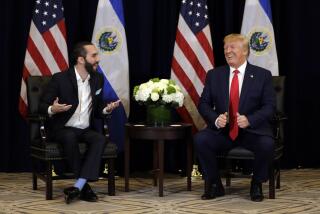Salvador Civil War Becoming Battle of U.S. Surrogates
SAN SALVADOR — When El Salvador’s Marxist guerrillas decided to propose a peace plan that contained a radical change in their policy, they sent it first not to the government of El Salvador but to U.S. officials in Washington.
After U.S. officials intervened, President Jose Napoleon Duarte, who had originally rejected the plan, said he would give the guerrilla proposal serious consideration.
To a considerable extent, the nine-year-old civil war in El Salvador has become an American war fought by local surrogates.
“No serious decision is made here without clearing it first with the Americans,” a Western diplomat said recently, “and I mean not only the government but the army and even the FMLN (the Farabundi Marti National Liberation Front, as the rebels are known).”
Acting as Courier
This practice was underlined when the FMLN sent its plan to Washington on Jan. 19, using its political wing, the Revolutionary Democratic Front (FDR), as courier. The plan called for a delay in the presidential election, from March 19 to Sept. 15, and said the guerrillas would then take part in the election.
But the crucial part--that the FMLN would take part in the election--was written in only after meetings with key liberal members of Congress. There was no direct consultation with Administration officials, but the Revolutionary Democratic Front gave copies of the plan to the State Department before submitting it to the Salvadoran government.
Congressional sources denied that changes were made at their instigation, but they acknowledged that the switch came after the proposal was circulated in Washington on Jan. 19. The amended version was made public Jan. 23.
The American role here is the result of a decision made in 1979 that reversed a longstanding U.S. policy that deemed El Salvador of no serious importance to U.S. security. (From 1946 to 1979, U.S. aid to El Salvador totaled only $16.7 million). The decision-makers in 1979 took the position that the then-incipient insurrection was part of a Communist effort to overrun all Central America.
The change in attitude has resulted in billions of dollars for El Salvador in the 1980s, as well as direct input from the U.S. military, at least in terms of advising how the war should be fought.
Administrations starting with Jimmy Carter’s have argued that huge amounts of aid are needed to move El Salvador toward democracy and to professionalize its army so that it can defeat the guerrillas and win the support of the countryside.
Four Elections Cited
U.S. officials point to the four elections that El Salvador has had since 1982 as proof that democratization is working. Compared with the situation in the early part of the decade, human rights here are much improved, they say.
“No one can argue that El Salvador isn’t better off now than it was when we first got involved,” a U.S. official who has served here said.
Even though the official U.S. military presence is limited to 55 advisers, who are prohibited from engaging in combat, the American involvement goes well beyond that handful of individuals.
First, the actual number of U.S. military personnel is often triple the authorized number. This is accomplished by sending advisers here on temporary duty, which can last for up to 3 1/2 months.
Salvadoran soldiers wear U.S. uniforms, fire U.S.-made M-16 assault rifles and fly U.S. fighter planes and helicopters. The tactics the Salvadoran troops are supposed to use are American-designed.
Unintentionally, the guerrillas are also recipients of U.S. aid. Many of them wear the same uniforms and carry the same rifles--taken from government soldiers or provided by allies out of stocks the Americans left behind in Vietnam.
Bullets on Both Sides
“Both sides are killing each other with American weapons, American bullets,” a European diplomat remarked.”
U.S. involvement goes well beyond military matters, however. In 1982, and again in 1984, the United States used money and influence to prevent the extremist right-wing Nationalist Republican Alliance, often called the Arena party, from winning the presidency.
There is also an economic aspect to the U.S. involvement. Since 1980, the United States has poured about $3.6 billion into El Salvador, and at present the U.S. contribution averages more than $1 million a day. U.S. money makes up more than half the Salvadoran national budget.
“El Salvador as a country would not survive without the (U.S.) money,” Antonio Canas, a political economist at the University of Central America, said.
The influence of the American way is striking in the capital. Three Pizza Hut restaurants opened last year. Of seven available cable television channels, five are broadcast in English directly from the United States.
U.S. aid appears to have done little to benefit the Salvadoran people, meanwhile. There is less potable water available than there was 10 years ago. The national economy is growing at a respectable rate as a result of the U.S. aid, but for the majority of people the standard of living has fallen, at least in terms of purchasing power.
Corruption in the Duarte government, much of it in the form of fortunes amassed by some of his associates, is cited as the chief reason for the sharp fall in the popularity of the Christian Democratic Party, the object of covert American aid in the 1982 and 1984 election campaigns.
As a consequence, the rightist Arena party is expected to win the upcoming presidential election. If it does, it will put the United States in the position of propping up a government led by a party heavily influenced by former army Maj. Roberto D’Aubuisson--a man who has been accused of organizing death squads and plotting to assassinate an American ambassador.
If U.S. policy and money have not brought the economic growth and centrist political system that was desired, neither have they served to end human rights abuses or to shape an army capable of defeating the rebels anytime soon.
For example, Vice President Dan Quayle said on a recent visit to San Salvador that unless the military halts the abuse of human rights, El Salvador could lose its support in Congress--and thus its massive aid. But sources close to army leaders said the threat was not taken seriously.
“They just don’t think the Americans will cut off aid now, not after having lost to the Sandinistas (in Nicaragua) and when they think the guerrillas here can be defeated,” one source said.
That assumption evidently also exists among American policy makers in Washington and here at the U.S. Embassy; at least, that is the reading given by some foreign diplomats to explain the embassy’s reaction to the FMLN peace proposal.
Although the State Department said the proposal was “worthy of serious and substantive consideration,” U.S. officials here make it clear that they think the plan is not a serious effort.
“I have a great deal of cynicism that they played this as a change of policy,” one U.S. official here said.
This official said the war is not at a stalemate, even though government troops have been on the defensive for two months and have not been able to prevent FMLN forces from attacking targets nationwide.
According to military experts, this is caused in large part by the failure of Salvadoran military leaders to fully implement the counterinsurgency tactics advocated by U.S. advisers.
Salvadoran troops are said to be reluctant to operate at night, to set up ambushes, to establish effective defense lines around their camps or to pursue guerrillas aggressively after a fight. They prefer large-scale operations called sweeps, which the guerrillas usually elude.
More to Read
Sign up for Essential California
The most important California stories and recommendations in your inbox every morning.
You may occasionally receive promotional content from the Los Angeles Times.










